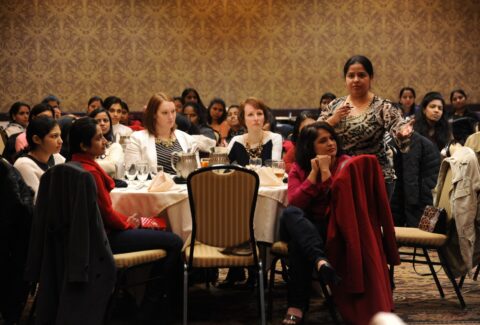“Great stories happen to those who can tell them”
- Ira Glass
The Story Rules Content Hub
Welcome to the Story Rules Content Hub – the best place on the web to learn all about storytelling techniques for work. Here’s where you get rich storytelling examples, analyses, viewpoints, interview nuggets, visuals, quotes, and much, much more. To find out how you can make the most of this resource, please watch this 12-minute video.
You can explore this (for now free!) resource in four ways:
Explore by Objective
Search the Content Hub!
Explore by Storytelling Technique
Explore by content type
Filter
Trending from the blog
The story of how we got our daughter home (PS: Mandira Bedi, we owe you one)
I was not comfortable. It was five-thirty in the evening as Praveena (the better half) and I were trundling in a white Swift Dzire on a long road with too little traffic for my comfort. We were midway on the road from Patna to a small town called Begusarai (so much character in that name!) in Bihar, India. It was winter in India – the sun sets early. In Pune, where I live, sunset usually happens at around 6 pm, with another 15-20 minutes of twilight. However, this wasn’t Pune – this was Bihar. It’s not just to the north …
More stories about the little one… (and a bonus story from Begusarai)
Dear Swara, Just in case you happen to be reading this when you’ve grown-up… Here’s a confession. I’ve been sharing some stories of yours with my extended circle of friends and well-wishers… without your explicit permission. I hope that’s ok. Perhaps you will read these letters with a wry smile on your face… but perhaps some part of you might be thinking… “Whoa, Appa … boundaries!!” To that privacy-seeking part, here’s my message. I understand that I’m not exactly being discreet with your stories here. But think of these as benefiting a larger audience in taking a critical life decision …
Want to refute something? Don’t deny it. Instead, manufacture doubt
Today being the first Saturday of the month, it is time for my content recommendations – a book, a podcast, articles and videos. Let’s get started 1. Book a. ‘How to Make the World Add Up: Ten Rules for Thinking Differently About Numbers’ by Tim Harford In 1953, senior executives from the tobacco industry met at the Plaza Hotel in New York. They were meeting to discuss a recent study by a couple of British scientists. In the study, the scientists – after a painstaking randomised control trial – had come to a shocking conclusion which for the first time linked …
A data-storytelling insight from the Jyotirlinga story
(This week’s a short one – but hopefully, enjoyable nevertheless!) Among the Hindu Gods trinity of Brahma (Creator), Vishnu (Preserver) and Shiva (Destroyer), devotees’ prayers are not distributed equally. While there are scores of temples to Vishnu and Shiva, poor ol’ Brahma has to contend with just a handful, with the most prominent one being at Pushkar, Rajasthan. Clearly something major happened at a very early stage of Hinduism such that the entire diverse community (and future generations) eschewed building temples to this member of the Trinity with a fairly critical job description. Why so? Predictably the answer is in …
How I stumbled upon the word ‘Storyteller’ for what I do
Sometime in 2014, I was trying to figure out what to do next, after my 3-year stint at B-ABLE, a skill development firm. I eventually ended up co-founding Captivatour with Deepthi and Sid, but before that, I was exploring multiple options. Training and education were interest areas and one company I really admired was XSEED Education – so I wanted to find out if they had something relevant. A batch senior of mine was with that company and I sent my CV through him for a possible role. An interview was fixed. The interviewer was a leader called Anustup Nayak.Anustup is now a …
Three storytelling lessons from Kamala Harris’ stirring victory speech
In today’s edition, I’m sharing my quick take on some storytelling elements used in the victory speech by the US VP-Elect Kamala Harris. (This being Diwali, I thought it’s appropriate to share a story about the victory of good over evil 😉 If you haven’t watched/ read the speech yet, you can do so here (video) and here (transcript). It’s a powerful speech – emotionally resonant and yet clear headed. A fitting articulation of a historically significant moment. In the address, Harris has used many storytelling techniques; I’m going to pick three interesting ones that caught my eye. 1. Begin …
The most consequential napkin art of all time (or was it?)
Today being the first Saturday of the month, it is time for my content recommendations – books, a podcast, articles and videos. Let’s get started 1. Books a. ‘Narrative Economics’ by Robert Shiller On the 13th of September 1974, probably the most famous curve of all time was drawn on a table napkin in a restaurant in Washington DC. Here’s the scene. Four men at the table. A journalist (Jude Wanniski, who was the one who later wrote about it), two top White House officials (future VP Dick Cheney and future Defense Secretary Donald Rumsfeld) and the our main guy – …
Our struggle with Probability
Today I’m sharing an old article that I wrote – back in early 2015, when I was figuring out what to do after leaving my job at an NGO. I briefly flirted with blogging, but then moved on to co-found a startup focused on history storytelling. During that period of blogging, I wrote something about the role of probability and how our struggle with it defines such a large part of what we do. This piece is written from the point of view of organised religion – but it applies to a lot of aspects of life. Look forward to your thoughts …
An ode to the patron Goddess of Storytelling 🙂
My dad loves listening to talks and lectures on spirituality. He often shares little-known stories from the unending storehouse that is Indian mythology. Recently he shared a fascinating story about Goddess Saraswati – the Hindu Goddess of Learning and Music (about whom I hadn’t heard very many stories)! It is a little known side-story from the epic Ramayana. As we all know, Lord Rama was an avatar of Lord Vishnu, sent down on earth to vanquish and kill Ravana, the ten-headed king of Lanka. Now here’s an interesting theory in this version of the story: When God comes down on …
The (revised!) 5Cs framework for thought leadership
A few months back I had written the “3R” framework for thought leadership: Read, Reflect and (W)rite. I, ahem, reflected on it since then… and realised that it was missing a few key pieces. So here is my revised thought-leadership model, conveniently christened as the 5Cs Framework. In order to be a thought leader, you need to: Consume – Cerebrate – Confer – Create – Coach Let’s dive in. 1. Consume: Reading is, of course, critical. But just ‘reading’ is too narrow. Different people get their information in different ways. Some prefer visual inputs, while others like to listen to stuff. Do what …
Newsletter
Tags
Subscribe to the free newsletter
Join the '3-2-1 by Story Rules' newsletter and get an e-book that decodes the hidden storytelling structure used by Jeff Bezos, Bill Gates, and Warren Buffett.
Explore by Goal
© 2022 Ravishankar S Iyer. All Rights Reserved. Powered by Adaptive Art











